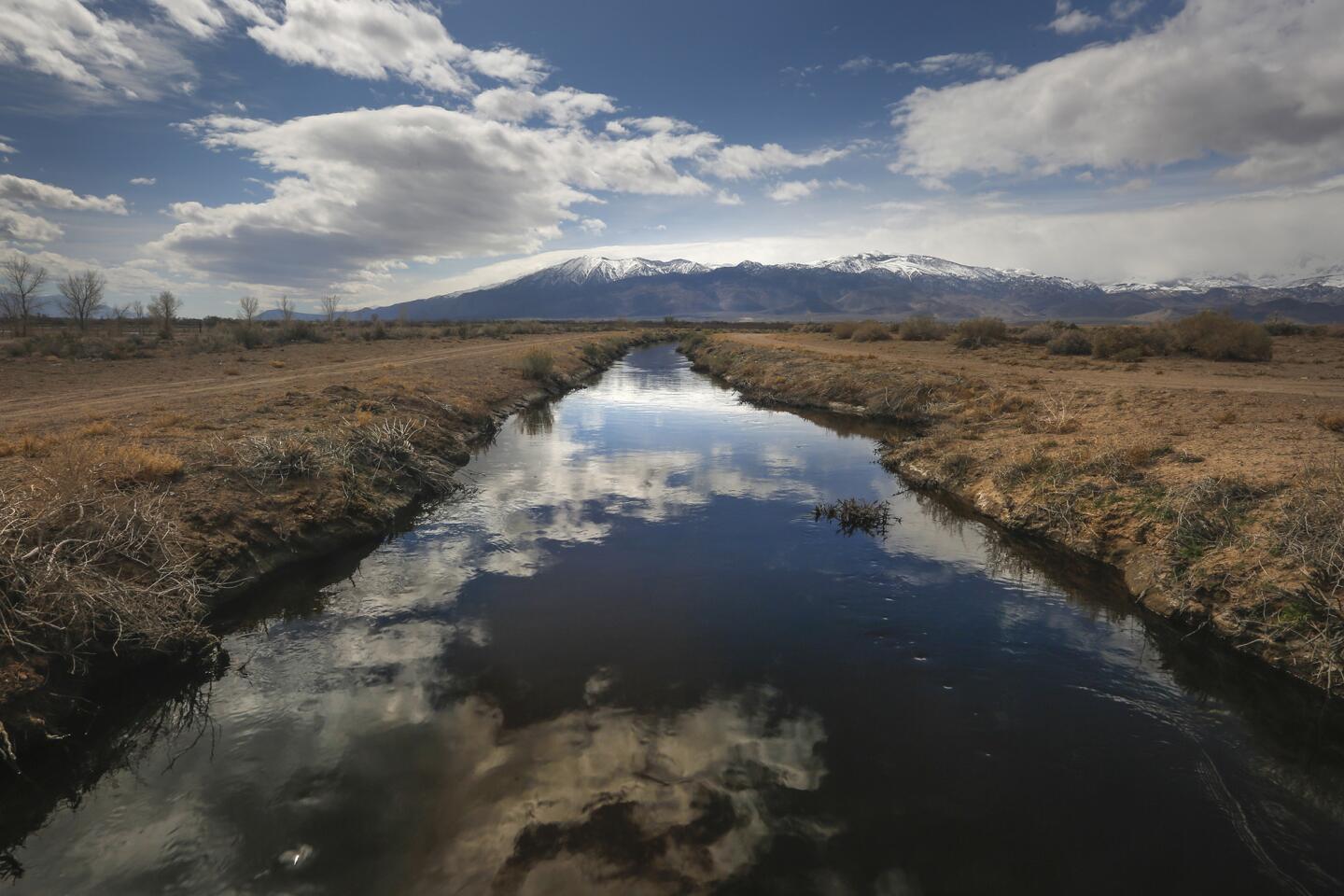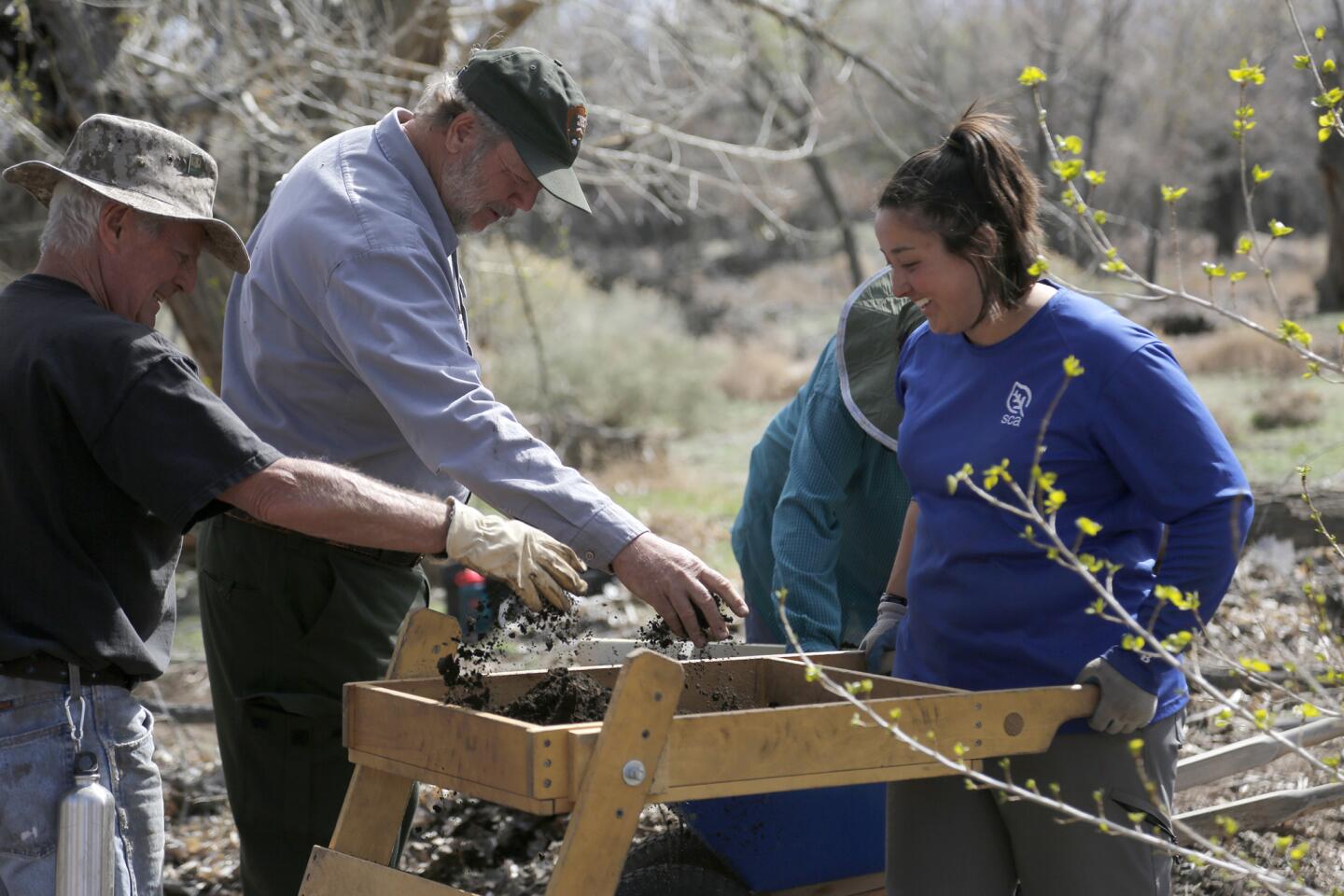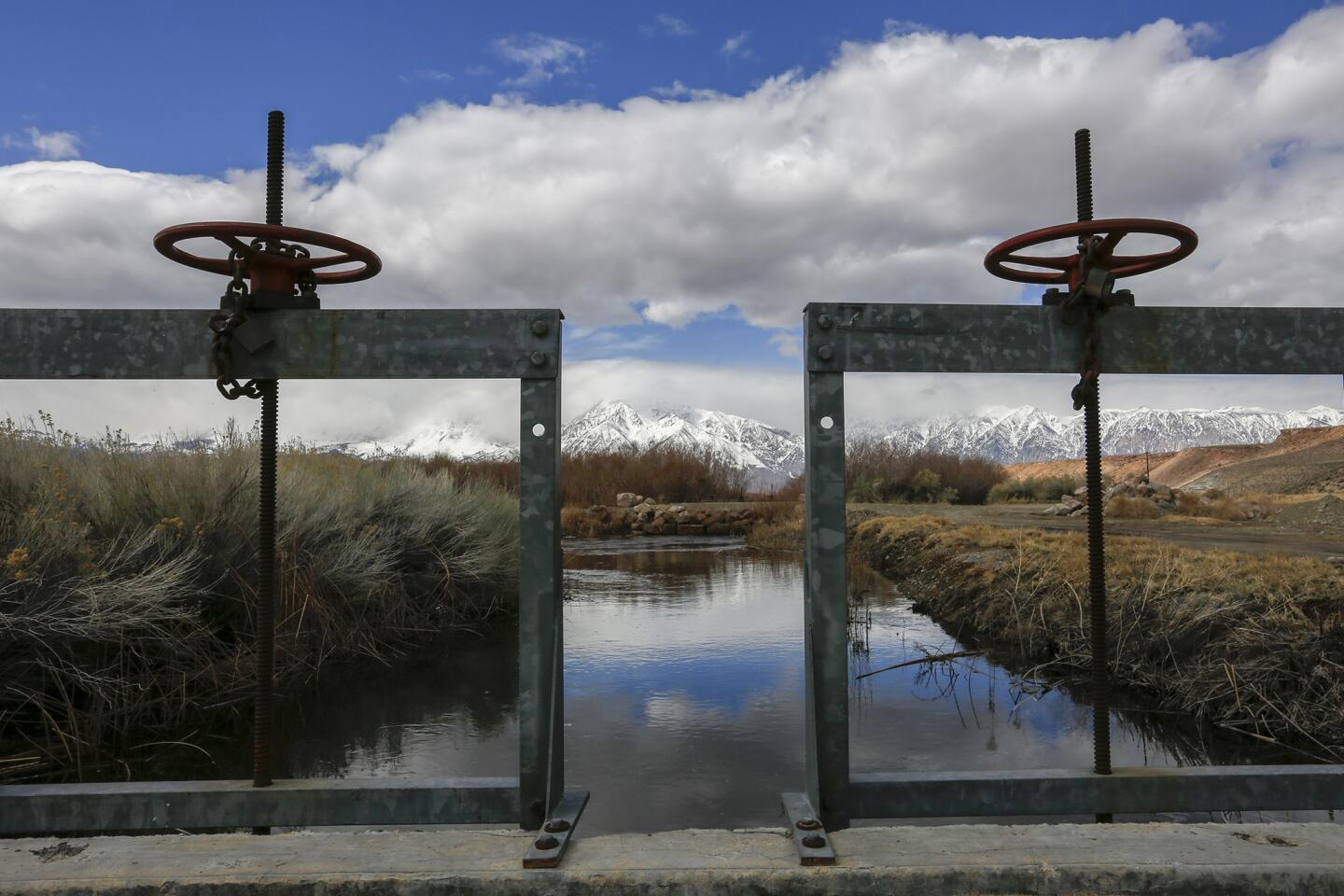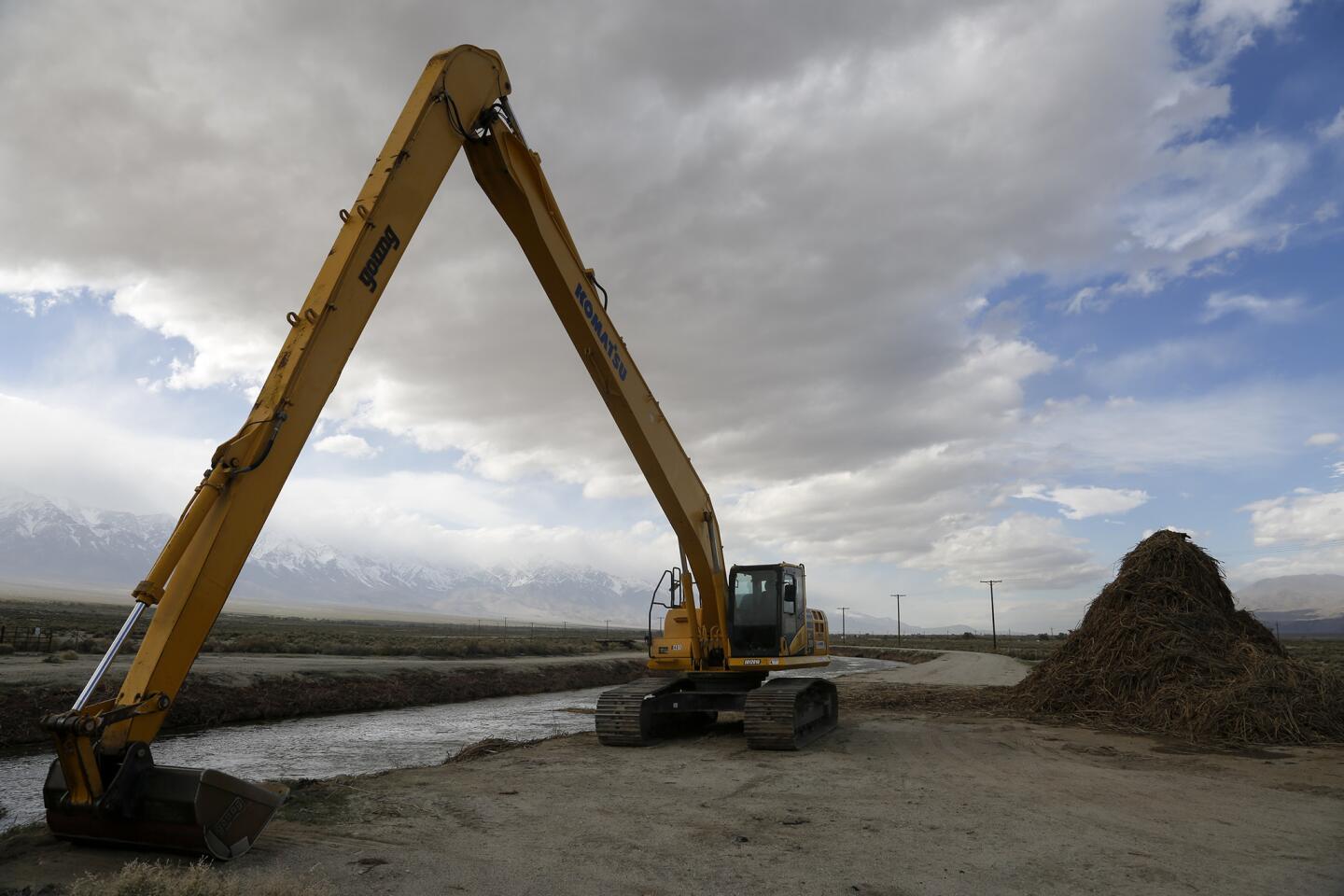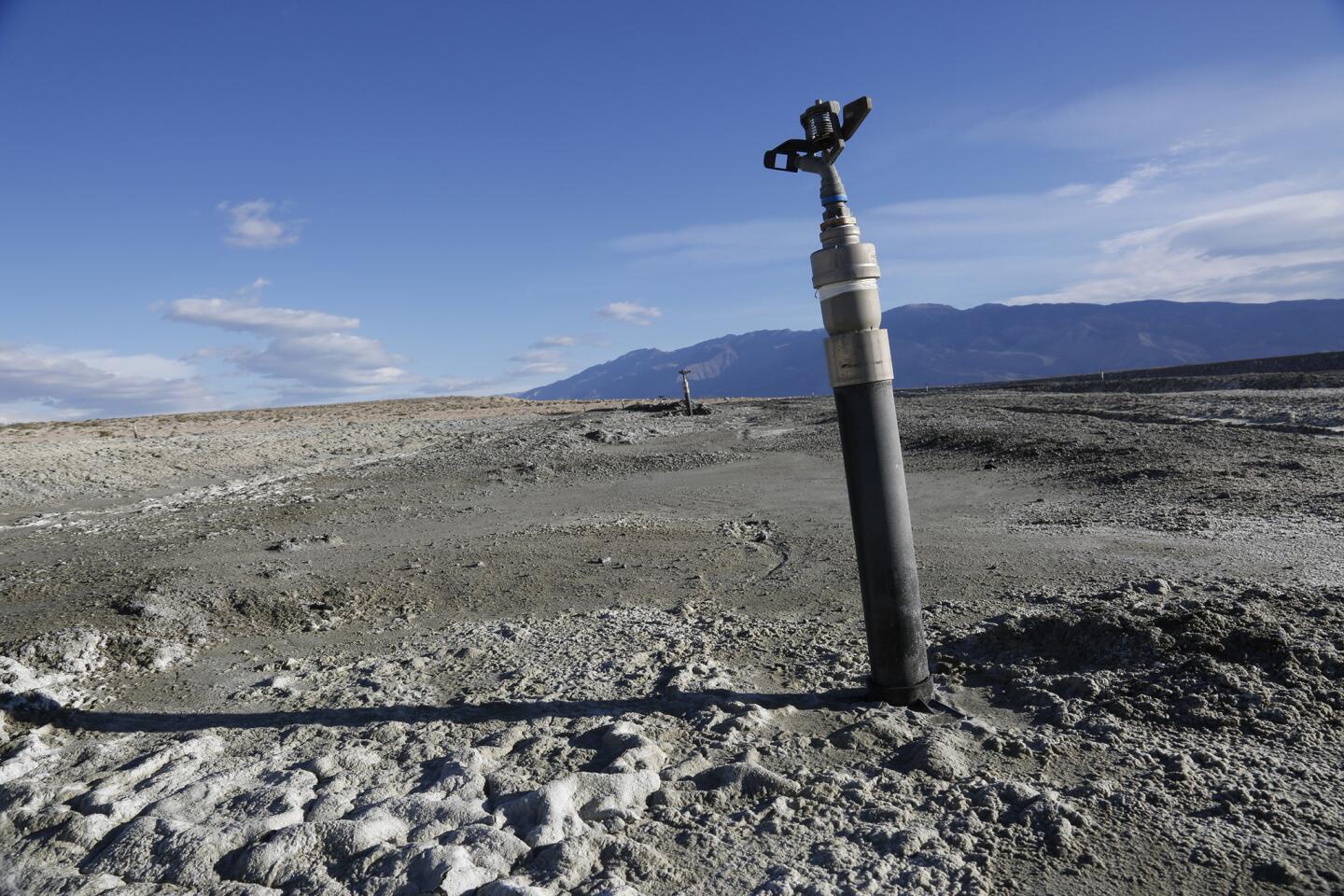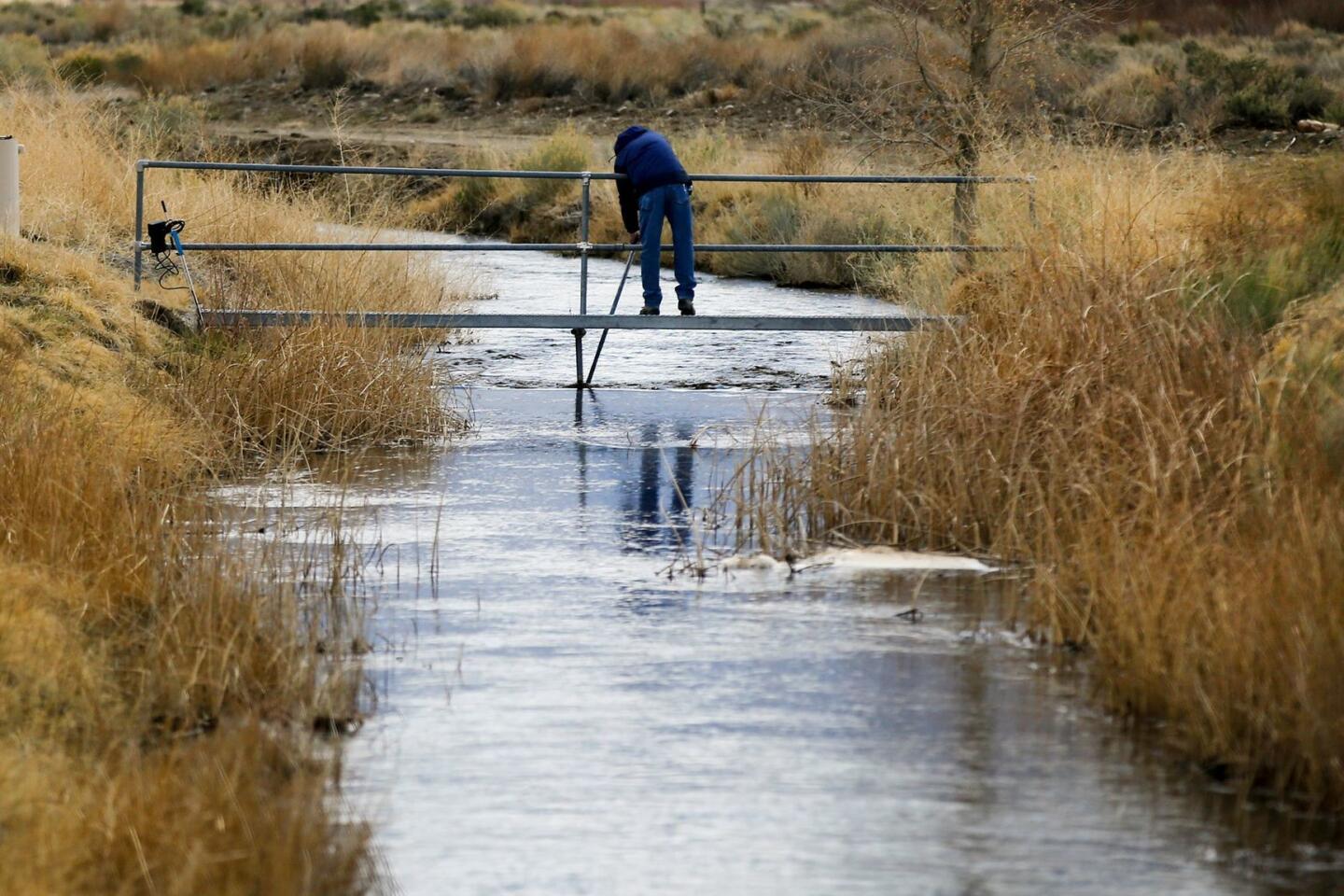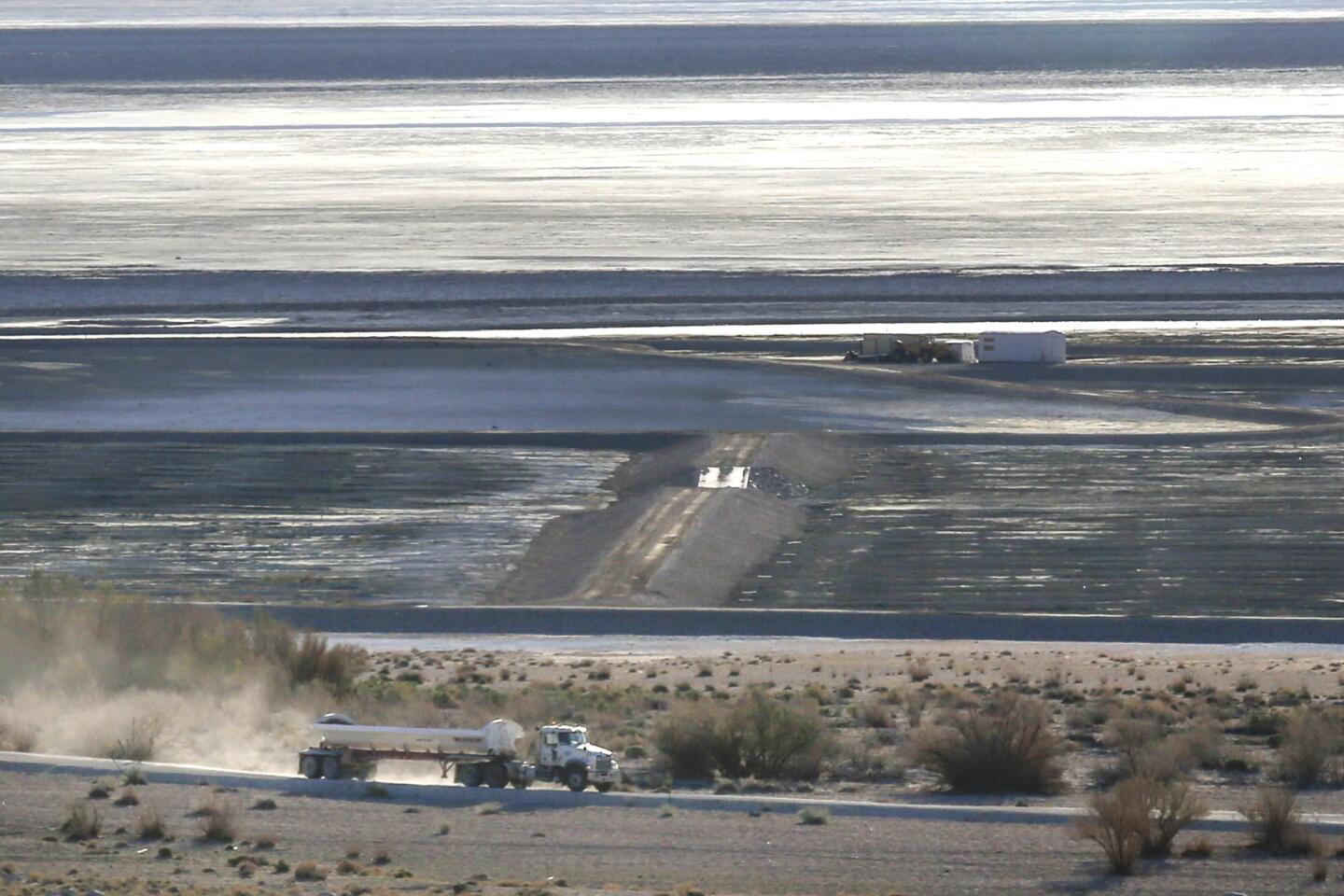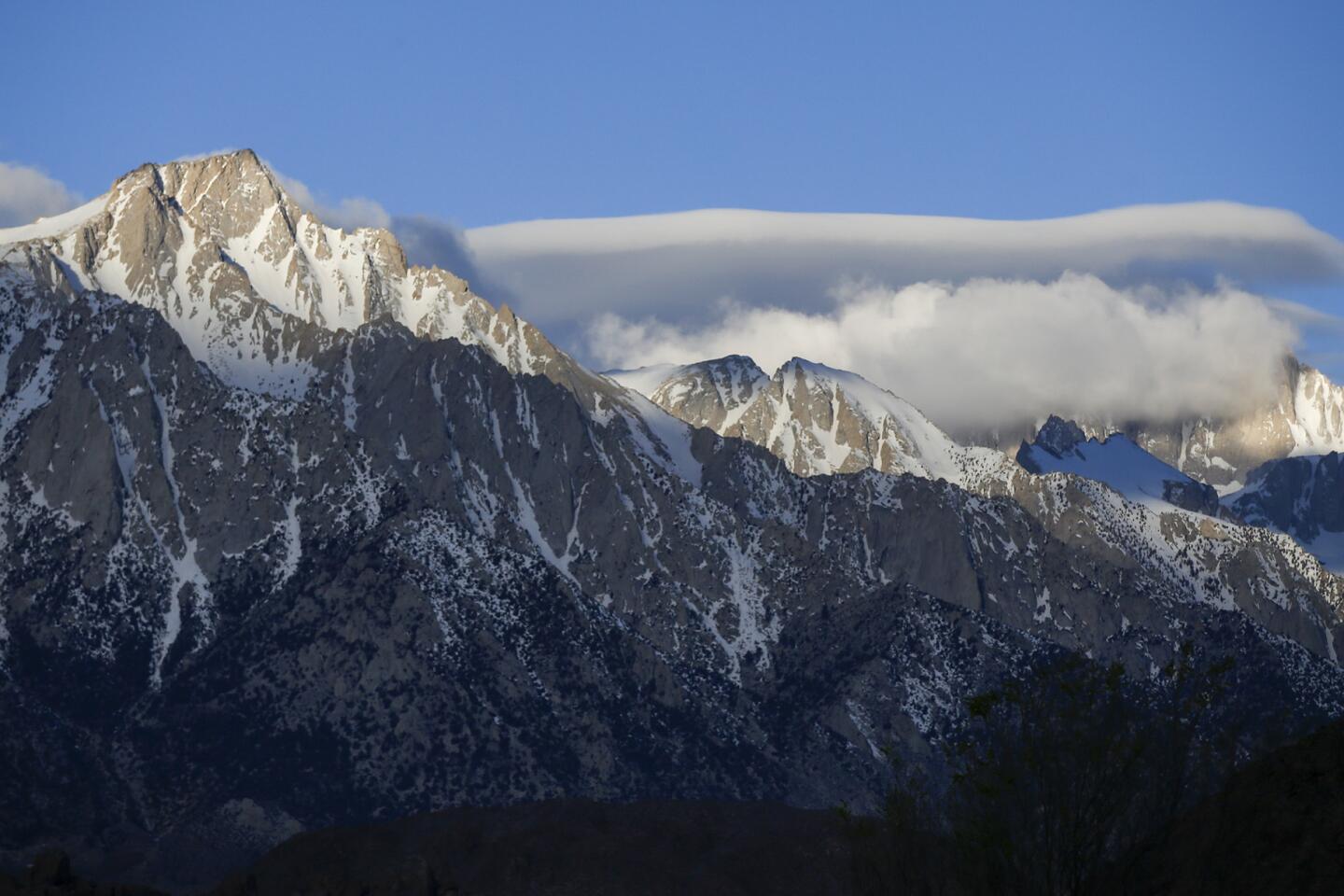Why record snow followed by warm temperatures is a dangerous combination for Owens Valley
Reporting from Lone Pine, Calif. — A sudden abundance of snowmelt has rendered a stunning spring landscape in the Owens Valley.
In sleepy towns such as Lone Pine, Big Pine and Independence, an all-but-forgotten sound adds to the serenity, as water again gurgles in every ditch and drain pipe.
But those welcome sounds of water have triggered a cacophony throughout the valley. Crews with chain saws clear culverts, bulldozers reshape reservoirs and backhoes clank and roar in the century-old aqueduct that is a key source of Los Angeles’ water.
With snowpack levels at 241% of normal, Los Angeles Mayor Eric Garcetti recently issued an emergency declaration allowing the Department of Water and Power to take immediate steps to “armor” the aqueduct system. This means reinforcing ditches and stream banks with rocks and boulders, and bulldozing up new berms to protect the lattice of plumbing and acres of gravel beds the DWP built as part of its $1-billion dust-control project on dry Owens Lake, which L.A. drained to slake its thirst.
If the work crews lose the race, the 1 million acre-feet of water expected to flow through the century-old aqueduct system this spring and summer could overflow, damaging the web of earth and concrete channels and inundating not just the sprawling lake bed, but fields, homes and businesses.
DWP activities, however, have elicited concern in the Owens Valley since the turn of the 20th century, when Los Angeles agents posed as ranchers and farmers to buy land and water rights in the area. Their goal was to build the aqueduct system to meet the needs of the growing metropolis 200 miles to the south.
I want every DWP facility, ditch, diversion bypass, canal and conveyance structure available and operating as soon as possible.
— Inyo County Administrator Kevin Carunchio
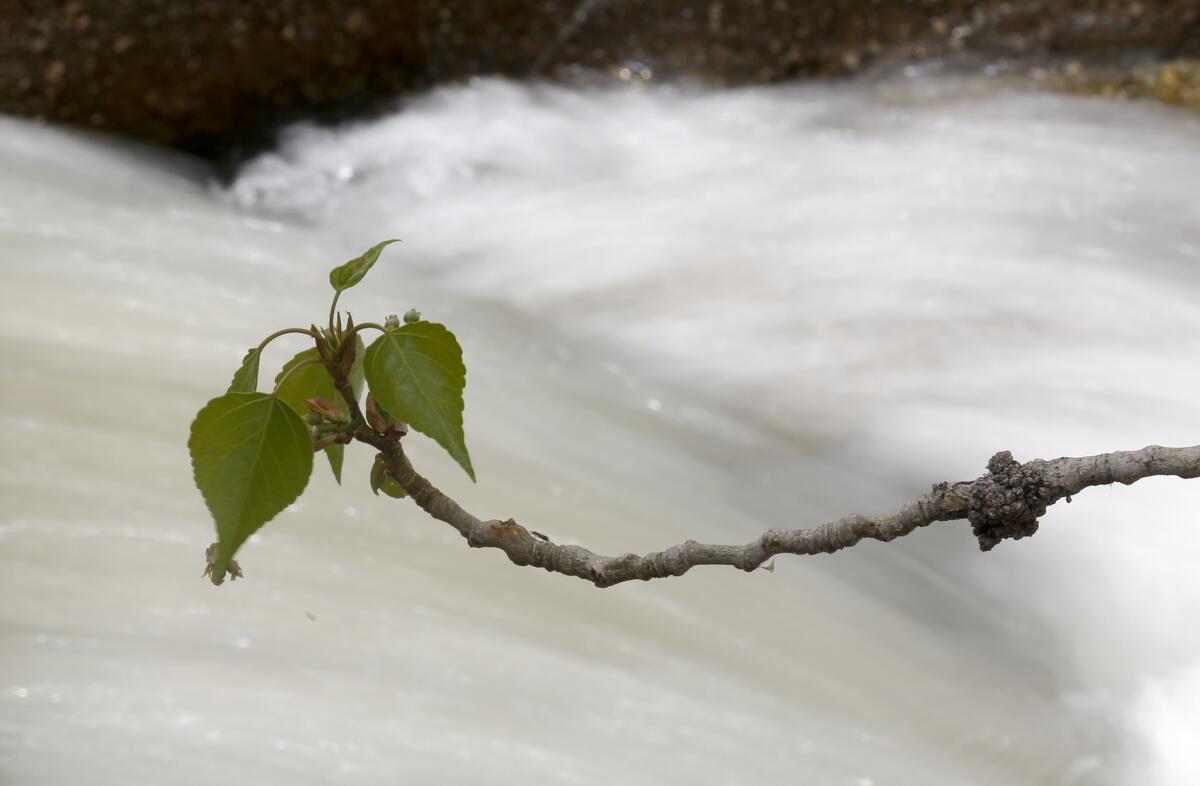
The stealth used to obtain the region’s land and water rights became grist for books and movies — most famously “Chinatown” — that portrayed the dark underbelly of Los Angeles’ formative years and inspired deep-seated suspicions about the city’s motives that linger to this day.
Officials insist that the current emergency poses a real threat not just to urban Los Angeles’ residents’ water supply, but to the ranchers, farmers, outdoor enthusiasts and small-business owners living in the sage-scented high desert gap between the peaks that frame the valley, some taller than 14,000 feet.
“Conditions of extreme peril” threaten the aqueduct system and valley residents, Garcetti said.
I’m going to declare a state of emergency if our tourism industry goes down the toilet.
— Tawni Thompson, director of the Bishop Chamber of Commerce and Visitors Bureau

With snowpack levels at 241% of normal, Los Angeles Mayor Eric Garcetti a week ago issued an emergency declaration allowing the Department of Water and Power to take immediate steps to shore up its aqueduct and its $1-billion dust-control project on
The crews swarming the valley are focused on protecting DWP infrastructure and a 110-mile stretch of U.S. 395, the principal route between Southern California and eastern resort areas. This leaves some folks living in the valley’s bucolic towns fretting that they are being overlooked.
The emergency is already taking a toll on the tourism industry.
The Bishop Chamber of Commerce & Visitors Bureau, for example, was forced to cancel the 50th annual Blake Jones Trout Derby scheduled for March 11 after the DWP rescinded its permission to hold the event because of dangerously high waters jumping the banks of the Owens River, just north of town.
“Losing the derby was a $300,000 hit to the local economy,” said Tawni Thompson, director of the chamber. “We’ll never know how many vacationers decided not to come through Bishop because they were scared of dying in a flood.”
“I’m going to declare a state of emergency,” she added, “if our tourism industry goes down the toilet.”
Bernadette Johnson, superintendent of the Manzanar National Historic Site on U.S. 395, has been getting nowhere with requests for additional flood control measures along streams on DWP land just outside the boundaries of the location that was a Japanese American internment camp during World War II.
“We were hit by destructive flooding earlier this year, and in 2013 and 2014,” Johnson said. “But the DWP is saying that when all hell breaks loose they won’t have enough resources and manpower to help us. We have to wonder about their priorities.”
In long legal battles spanning decades, the DWP was eventually forced to give up significant amounts of water to steady water levels in Mono Lake, re-water parts of dry Owens Lake to help prevent dust storms and restore a 62-mile stretch of the Lower Owens River.
Many residents suspect that the DWP plans to use emergency declarations to bypass rules and regulations that have prevented it from constructing paved roads, pumps and other infrastructure that would make it easier to do the dust control work on Owens Lake, which is owned by the State Lands Commission.
Richard Harasick, head of the DWP’s water system, dismissed that notion: “The department is not using this emergency declaration to take some sort of advantage or build special projects that would otherwise have to go through the normal regulatory process.”
“It is as much to help us manage the anticipated floodwaters as to aid in public safety,” he said. “It allows us to get goods, services and contracts faster, from heavy equipment to riprap needed to shore up banks and channels.”
This week, Inyo, Kern and Mono counties were expected to issue their own emergency declarations, making them eligible for state and federal assistance in the event of flooding.
“My proclamation will ask for critical resources,” Inyo County Administrator Kevin Carunchio said. “In the meantime, I want every DWP facility, ditch, diversion bypass, canal and conveyance structure available and operating as soon as possible.”
The region has a history of destructive floodwaters rushing off the High Sierra.
In August 1989, for example, cloudbursts driven by 60-mph winds gouged out the dirt that held up the aqueduct near Cartago and closed a 63-mile stretch of U.S. 395.
Jon Klusmire, administrator of the Eastern California Museum in Independence, isn’t taking any chances along a usually docile creek.
“I’ve devised a survival strategy for a worst-case scenario,” he said. “I’m going to jam some boards in a nearby DWP diversion gate, then dig a ditch to divert the water away from the museum and into the streets.”
How could it be that Los Angeles never developed a Plan B in a place where massive snowpack and destructive flooding go with the terrain?
— Kathy Jefferson Bancroft, tribal historic preservation officer for the Lone Pine Paiute-Shoshone Reservation
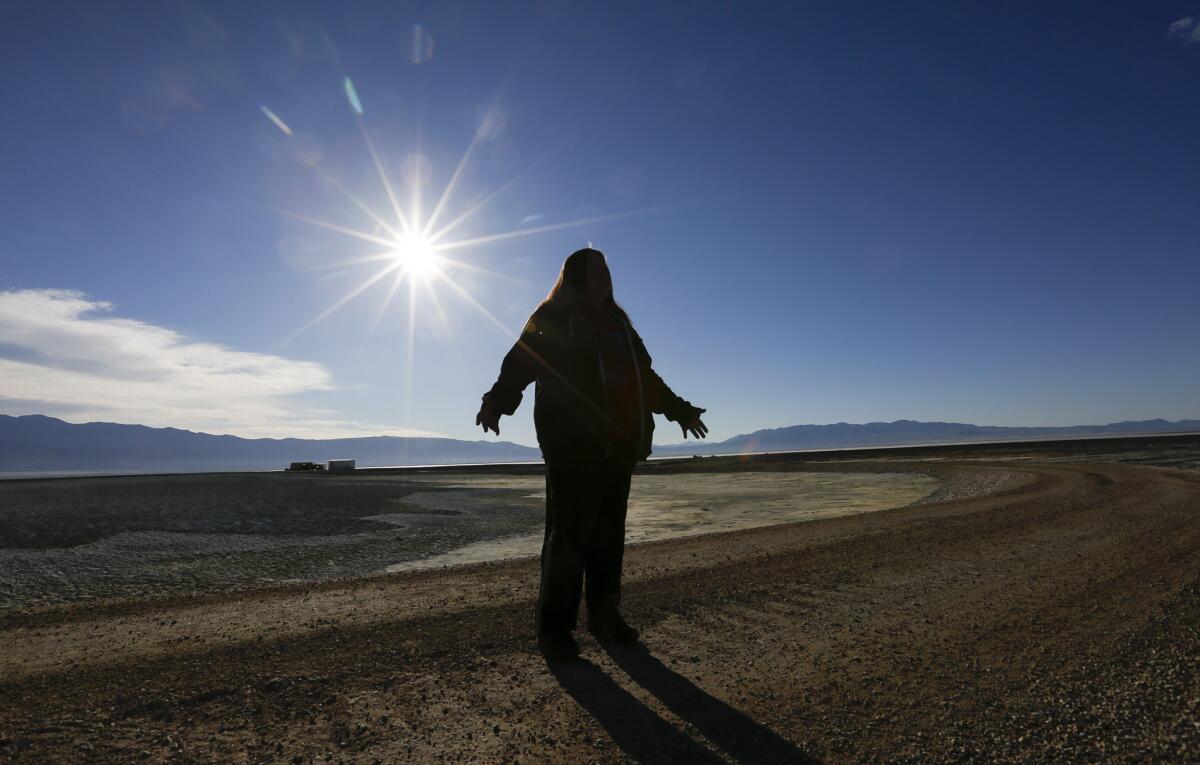
The big question for Kathy Jefferson Bancroft, tribal historic preservation officer for the Lone Pine Paiute-Shoshone Reservation, is this: “How could it be that Los Angeles never developed a Plan B in a place where massive snowpack and destructive flooding go with the terrain?”
Over the last 20 years the DWP has used shallow flooding, gravel and plots of vegetation to cut the dust across 50 miles of dry lake bed.
Bancroft surveyed some of the work from a dirt berm. “They’ve reduced dust pollution here by 96% with these projects,” she said. “And they’re all going to be underwater soon.
“Honestly, I’m looking forward to seeing this lake filled up again, like it is supposed to be,” she said.
That vista will be short-lived. The runoff is expected to evaporate within 12 to 18 months, leaving Los Angeles to repair damage to its dust abatement work and aqueduct system that could cost up to $500 million, officials said.
The rebuilding effort will be done in cooperation with state and federal regulatory agencies, local authorities and stakeholders, the State Lands Commission, which owns the lake bed, and the Great Basin Unified Air Pollution Control District, which is responsible for protecting the health of Owens Valley residents.
“When we’re done, it’ll be something different than what exists today,” Harasick said. “That’s because we plan to make it more flood-resilient.”
ALSO
UPDATES:
11:24 a.m.: This story was updated with additional material.
5:15 p.m.: This article was updated with additional details.
This article was originally published at 3 a.m.
More to Read
Sign up for Essential California
The most important California stories and recommendations in your inbox every morning.
You may occasionally receive promotional content from the Los Angeles Times.
